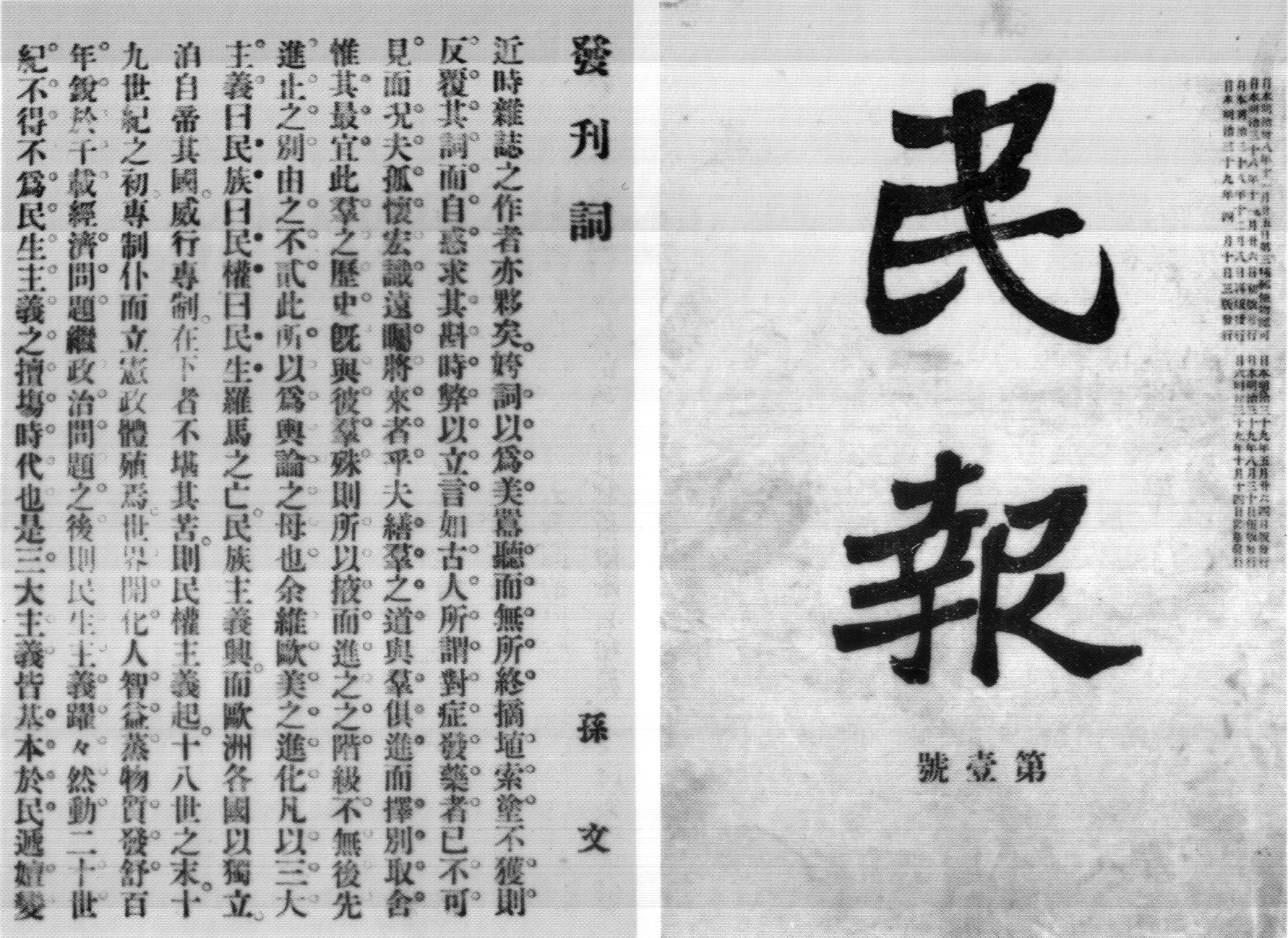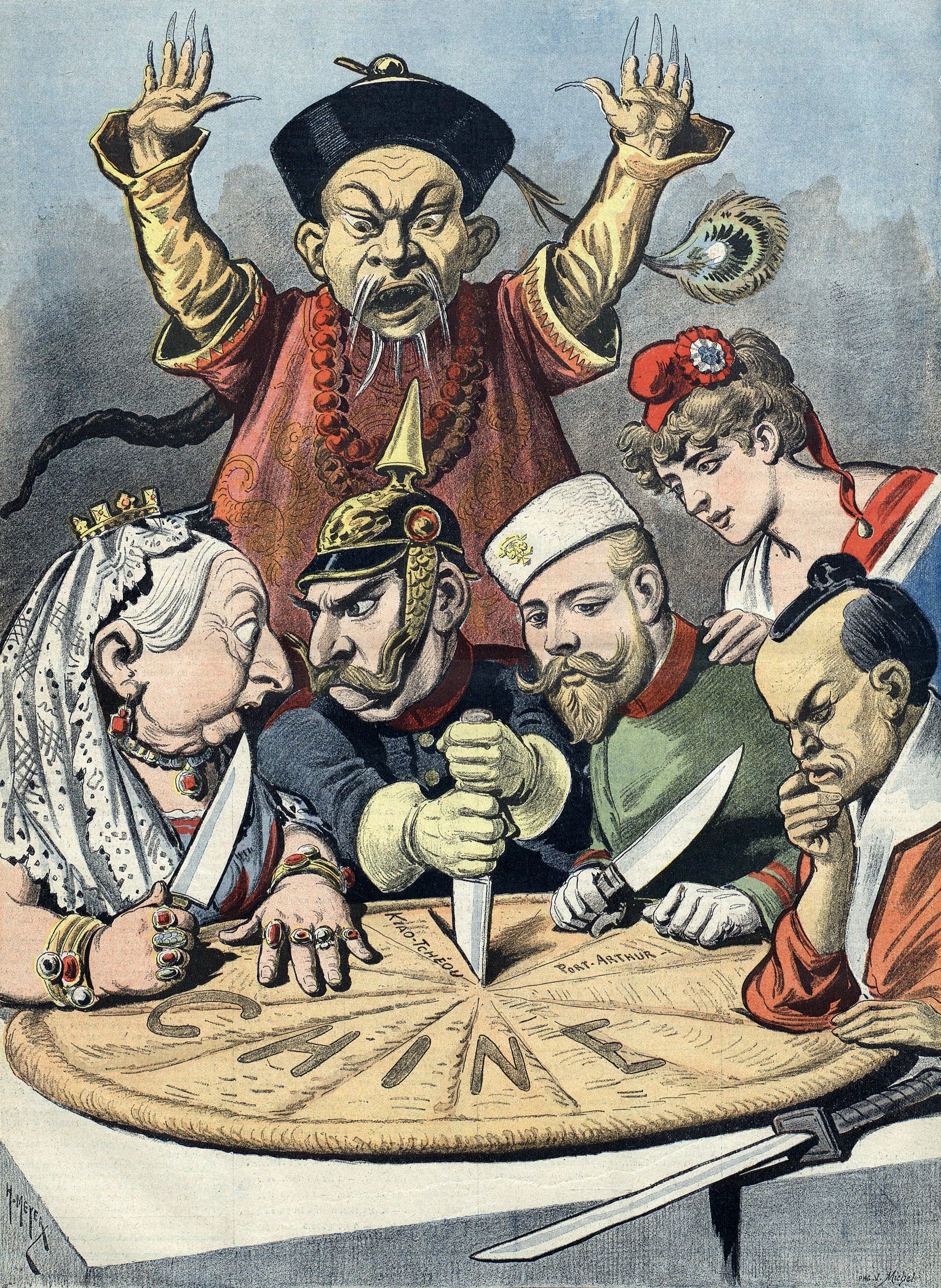|
Three Principles Of People
The Three Principles of the People (; also translated as the Three People's Principles, San-min Doctrine, or Tridemism) is a political philosophy developed by Sun Yat-sen as part of a philosophy to improve China made during the Republican Era. The three principles are often translated into and summarized as nationalism, democracy, and the livelihood of the people. This philosophy has been claimed as the cornerstone of the nation's policy as carried by the Kuomintang (KMT); the principles also appear in the first line of the national anthem of the Republic of China. Origins In 1894 when the Revive China Society was formed, Sun only had two principles: nationalism and democracy. He picked up the third idea, welfare, during his three-year trip to Europe from 1896 to 1898.Li Chien-Nung, translated by Teng, Ssu-yu, Jeremy Ingalls. ''The political history of China, 1840–1928''. Princeton, NJ: Van Nostrand, 1956; rpr. Stanford University Press. , . pp. 203–206. He announced all ... [...More Info...] [...Related Items...] OR: [Wikipedia] [Google] [Baidu] |
Sun Yat-sen
Sun Yat-sen (; also known by several other names; 12 November 1866 – 12 March 1925)Singtao daily. Saturday edition. 23 October 2010. section A18. Sun Yat-sen Xinhai revolution 100th anniversary edition . was a Chinese politician who served as the first provisional president of the Republic of China and the first leader of the Kuomintang (Nationalist Party of China). He is called the "Father of the Nation" in the Republic of China, and the "Forerunner of the Revolution" in the People's Republic of China for his instrumental role in the overthrow of the Qing dynasty during the Xinhai Revolution. Sun is unique among 20th-century Chinese leaders for being widely revered in both Mainland China and Taiwan. Sun is considered to be one of the greatest leaders of modern China, but his political life was one of constant struggle and frequent exile. After the success of the revolution in 1911, he quickly resigned as president of the newly founded Republic of China and relinquished ... [...More Info...] [...Related Items...] OR: [Wikipedia] [Google] [Baidu] |
Nationalism
Nationalism is an idea and movement that holds that the nation should be congruent with the State (polity), state. As a movement, nationalism tends to promote the interests of a particular nation (as in a in-group and out-group, group of people),Anthony D. Smith, Smith, Anthony. ''Nationalism: Theory, Ideology, History''. Polity (publisher), Polity, 2010. pp. 9, 25–30; especially with the aim of gaining and maintaining the nation's sovereignty (self-governance) over its homeland to create a nation-state. Nationalism holds that each nation should govern itself, free from outside interference (self-determination), that a nation is a natural and ideal basis for a polity, and that the nation is the only rightful source of political power. It further aims to build and maintain a single national identity, based on a combination of shared social characteristics such as culture, ethnicity, geographic location, language, politics (or the government), religion, traditions and belief ... [...More Info...] [...Related Items...] OR: [Wikipedia] [Google] [Baidu] |
Manchus
The Manchus (; ) are a Tungusic East Asian ethnic group native to Manchuria in Northeast Asia. They are an officially recognized ethnic minority in China and the people from whom Manchuria derives its name. The Later Jin (1616–1636) and Qing (1636–1912) dynasties of China were established and ruled by the Manchus, who are descended from the Jurchen people who earlier established the Jin dynasty (1115–1234) in northern China. Manchus form the largest branch of the Tungusic peoples and are distributed throughout China, forming the fourth largest ethnic group in the country. They can be found in 31 Chinese provincial regions. Among them, Liaoning has the largest population and Hebei, Heilongjiang, Jilin, Inner Mongolia and Beijing have over 100,000 Manchu residents. About half of the population live in Liaoning and one-fifth in Hebei. There are a number of Manchu autonomous counties in China, such as Xinbin, Xiuyan, Qinglong, Fengning, Yitong, Qingyuan, Weichang, Kua ... [...More Info...] [...Related Items...] OR: [Wikipedia] [Google] [Baidu] |
Tibetans
The Tibetan people (; ) are an East Asian ethnic group native to Tibet. Their current population is estimated to be around 6.7 million. In addition to the majority living in Tibet Autonomous Region of China, significant numbers of Tibetans live in the Chinese provinces of Gansu, Qinghai, Sichuan, and Yunnan, as well as in India, Nepal, and Bhutan. Tibetan languages belong to the Tibeto-Burman language group. The traditional or mythological explanation of the Tibetan people's origin is that they are the descendants of the human Pha Trelgen Changchup Sempa and rock ogress Ma Drag Sinmo. It is thought that most of the Tibeto-Burman speakers in Southwest China, including Tibetans, are direct descendants from the ancient Qiang people. Most Tibetans practice Tibetan Buddhism, although some observe the indigenous Bon religion and there is a small Muslim minority. Tibetan Buddhism influences Tibetan art, drama and architecture, while the harsh geography of Tibet has produced an adap ... [...More Info...] [...Related Items...] OR: [Wikipedia] [Google] [Baidu] |
Mongols In China
Mongols in China or Mongolian Chinese () are ethnic Mongols who were integrated into the nation-building of the Republic of China (1912–1949) after the fall of Qing Empire (1636–1911). Those not integrated broke away in the Mongolian Revolution of 1911 and again in 1921. The Republic of China recognized Mongols to be part of the Five Races Under One Union. Its successor, the People's Republic of China (1949-), recognized Mongols to be one of the 55 ethnic minorities in China. As of 2020, there are 6,290,204 Mongols in China, a 0.45% increase from the 2010 national census. Most of them live in Inner Mongolia, Northeast China, Xinjiang and Qinghai. The Mongol population in China is nearly twice as much as that of the sovereign state of Mongolia. Distribution The Mongols in China are divided between autonomous regions and provinces as follows: * 68.72%: Inner Mongolia Autonomous Region * 11.52%: Liaoning Province * 2.96%: Jilin Province * 2.92%: Hebei Province * 2.58%: X ... [...More Info...] [...Related Items...] OR: [Wikipedia] [Google] [Baidu] |
Han Chinese
The Han Chinese () or Han people (), are an East Asian ethnic group native to China. They constitute the world's largest ethnic group, making up about 18% of the global population and consisting of various subgroups speaking distinctive varieties of the Chinese language. The estimated 1.4 billion Han Chinese people, worldwide, are primarily concentrated in the People's Republic of China (including Mainland China, Hong Kong and Macau) where they make up about 92% of the total population. In the Republic of China (Taiwan), they make up about 97% of the population. People of Han Chinese descent also make up around 75% of the total population of Singapore. Originating from Northern China, the Han Chinese trace their cultural ancestry to the Huaxia, the confederation of agricultural tribes living along the Yellow River. This collective Neolithic confederation included agricultural tribes Hua and Xia, hence the name. They settled along the Central Plains around the middle and lo ... [...More Info...] [...Related Items...] OR: [Wikipedia] [Google] [Baidu] |
Five Races Under One Union
Description This principle emphasized harmony between what were considered the five major ethnic groups in China, as represented by the colored stripes of the Flag of the Republic of China, Five-Colored Flag of the Republic: the Han Chinese, Han (red); the Manchu people, Manchus (yellow); the Mongols in China, Mongols (blue); the Hui (white); and the Tibetan people, Tibetans (black).Fitzgerald, John. [1998] (1998). Awakening China: Politics, Culture, and Class in the Nationalist Revolution. Stanford University Press publishing. , . pg 180. The term , , primarily referred in this context to Muslims, as a whole, and as such for a certain period of time (before the 1911 Revolution, Xinhai Revolution) the term also referred to the Uyghurs in Western China, since the term "Muslim Territory" (; ) was an older name for Xinjiang during the Qing dynasty. The meaning of the term "Hui people" gradually shifted to Hui people, its current sense—a group distinguished from Han Chinese by their ... [...More Info...] [...Related Items...] OR: [Wikipedia] [Google] [Baidu] |
Zhonghua Minzu
''Zhonghua minzu'' (, ) is a political term in modern Chinese nationalism related to the concepts of nation-building, ethnicity, and race in the Chinese nationality. ''Zhonghua minzu'' was established during the early Beiyang (1912–1927) and Nationalist (1928–1949) periods to include Han people and four major non-Han ethnic groups: the Man (Manchus), the Meng (Mongols), the Hui (ethnic groups of Islamic faith in Northwest China), and the Zang (Tibetans), under the notion of a republic of five races ( or ''Wǔzú gònghé'') advocated by Sun Yat-sen and the Chinese Nationalist Party. It is slightly different from the word Hanzu, a word is only used to refer to the Han Chinese. ''Zhonghua minzu'' was initially rejected in the People's Republic of China (PRC) but resurrected after Mao Zedong's death to include the mainstream Han Chinese and 55 other ethnic groups as a huge Chinese family. Since the late 1980s, the most fundamental change of the PRC's nationalities an ... [...More Info...] [...Related Items...] OR: [Wikipedia] [Google] [Baidu] |
Chinese Nationalism
Chinese nationalism () is a form of nationalism in the People's Republic of China (Mainland China) and the Republic of China on Taiwan which asserts that the Chinese people are a nation and promotes the cultural and national unity of all Chinese people. It is often equated with Han nationalism, although these two concepts are different. According to Sun Yat-sen's philosophy in the Three Principles of the People, Chinese nationalism should be a form of civic nationalism constructed on top of a united value, however this has not been fully recognized or applied in practice by successors. Modern Chinese nationalism emerged in the late Qing dynasty (1636–1912) in response to the humiliating defeat in the First Sino-Japanese War and the invasion and pillaging of Beijing by the Eight-Nation Alliance. In both cases, the aftermath forced China to pay financial reparations and grant special privileges to foreigners. The nationwide image of China as a superior Celestial Empir ... [...More Info...] [...Related Items...] OR: [Wikipedia] [Google] [Baidu] |
Unequal Treaty
Unequal treaty is the name given by the Chinese to a series of treaties signed during the 19th and early 20th centuries, between China (mostly referring to the Qing dynasty) and various Western powers (specifically the British Empire, France, the German Empire, the United States, and the Russian Empire), and the Empire of Japan. The agreements, often reached after a military defeat or a threat of military invasion, contained one-sided terms, requiring China to cede land, pay reparations, open treaty ports, give up tariff autonomy, legalise opium import, and grant extraterritorial privileges to foreign citizens. With the rise of Chinese nationalism and anti-imperialism in the 1920s, both the Kuomintang and the Chinese Communist Party used the concept to characterize the Chinese experience of losing sovereignty between roughly 1840 to 1950. The term "unequal treaty" became associated with the concept of China's " century of humiliation", especially the concessions to foreign powers ... [...More Info...] [...Related Items...] OR: [Wikipedia] [Google] [Baidu] |
Tariff
A tariff is a tax imposed by the government of a country or by a supranational union on imports or exports of goods. Besides being a source of revenue for the government, import duties can also be a form of regulation of foreign trade and policy that taxes foreign products to encourage or safeguard domestic industry. ''Protective tariffs'' are among the most widely used instruments of protectionism, along with import quotas and export quotas and other non-tariff barriers to trade. Tariffs can be fixed (a constant sum per unit of imported goods or a percentage of the price) or variable (the amount varies according to the price). Taxing imports means people are less likely to buy them as they become more expensive. The intention is that they buy local products instead, boosting their country's economy. Tariffs therefore provide an incentive to develop production and replace imports with domestic products. Tariffs are meant to reduce pressure from foreign competition and reduce th ... [...More Info...] [...Related Items...] OR: [Wikipedia] [Google] [Baidu] |
Balance Of Trade
The balance of trade, commercial balance, or net exports (sometimes symbolized as NX), is the difference between the monetary value of a nation's exports and imports over a certain time period. Sometimes a distinction is made between a balance of trade for goods versus one for services. The balance of trade measures a flow of exports and imports over a given period of time. The notion of the balance of trade does not mean that exports and imports are "in balance" with each other. If a country exports a greater value than it imports, it has a trade surplus or positive trade balance, and conversely, if a country imports a greater value than it exports, it has a trade deficit or negative trade balance. As of 2016, about 60 out of 200 countries have a trade surplus. The notion that bilateral trade deficits are bad in and of themselves is overwhelmingly rejected by trade experts and economists. Explanation The balance of trade forms part of the current account, which includes ... [...More Info...] [...Related Items...] OR: [Wikipedia] [Google] [Baidu] |






.jpg)

.png)
